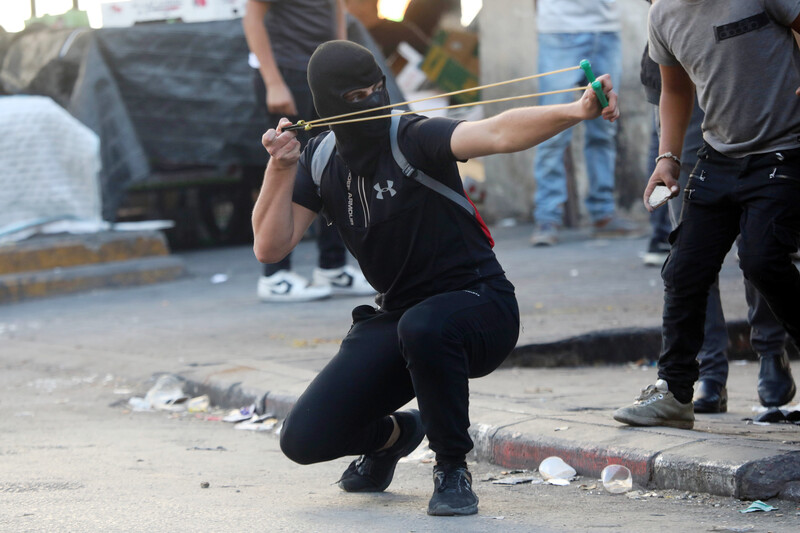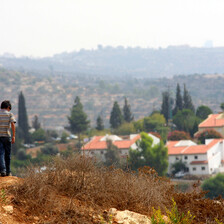The Electronic Intifada 27 October 2022

Nonviolence alone will not liberate Palestine.
APA imagesViolent military raids are a constant reality for Palestinians living under colonial Israeli military occupation.
To that end, as Mariam Barghouti and Yumna Patel argue in Mondoweiss, the vicious collective punishment comprising Israel’s Operation “Break the Wave,” launched in March of this year, should be understood as a “continuation” of Operation “Law and Order” that was launched against the 2021 unity intifada and Operation “Breaking Dawn” in the August 2022 assault on Gaza.
But something important distinguishes the latest series of brutal assaults: They are being met by an increasingly efficient Palestinian armed resistance, which includes fighters from most Palestinian armed groups including the Palestinian Islamic Jihad’s al-Quds Brigades and Fatah’s al-Aqsa Martyrs Brigades. Smaller, newly established armed resistance collectives such as the Lions Den have formed that may be supported by these larger, extant formations but also operate somewhat independently. They share members across Fatah, Hamas, PIJ and PFLP.
Writing for Al Jazeera, Zena Al Tahhan reports that the emergence of a new, coordinated generation of Palestinian resistance fighters has significantly impacted the calculations of Israeli officials, who cannot simply attack with impunity.
Sari Orabi, a Palestinian political analyst quoted in Al Tahhan’s piece, says that Israel’s August assault on Gaza “had to be short,” with quick, consecutive “fast hits on the PIJ. If it had gone on for longer, then we may have seen armed operations emerge in the West Bank.”
That Palestinian armed resistance has once more reached the point where it can influence the dictates of colonial military calculations is an important development, one that arguably bodes well for the prospect of Palestinian liberation. After all, liberation movements throughout history have deployed a diversity of tactics.
As Palestinian militancy grows, it’s important to revisit problematic and dehumanizing notions of Palestinian “nonviolence” as the exclusively acceptable form of resistance. My issue is not with nonviolent resistance as such (again, liberation struggles require a diversity of tactics) but the limiting ways in which it can be taken up in advocacy for Palestine.
More specifically, I believe there is a problematic, obsessive iteration of “nonviolence” within the broader Palestine solidarity movement that dehumanizes Palestinians, normalizes Zionism, and ultimately utilizes racist and colonial frameworks to advance the notion that the means of Palestinian resistance are more troubling than the reality of Zionist settler-colonialism.
As such, I believe this logic needs to be exposed and challenged so as to ensure a comprehensive respect for Palestinian humanity and agency in the ongoing struggle for liberation from the river to the sea.
Reductive Logic
Though published 13 years ago, American-born Israeli journalist Gershom Gorenberg’s piece “The Missing Mahatma” remains a great example of the reductive logic informing the dehumanizing liberal/Leftist fetishization of Palestinian “nonviolence.”
Gorenberg opens the article with a fictional episode involving a Palestinian of his own invention, Sheikh Nassar a-Din al-Masri, formerly a militant Hamas member who switched to nonviolent resistance after reading a treatise on the tactic by Syrian writer Jawdat Said, a relatively well-known Islamic scholar who preached nonviolence as the true message of Islam, in prison.
Gorenberg admits that al-Masri “exists only as the stand-in for a question: Why is there no Palestinian Gandhi, no Palestinian Martin Luther King?”
The seemingly untroubled entitlement with which this Israeli writer sees fit to use a fictionalized and parodic caricature of a living and breathing people bravely engaged in anti-colonial struggle to establish the moral tenor of his appeal seems an apt reflection of the dehumanizing arrogance of conditioning support for Palestinian liberation to the means of resistance alone.
Also referenced is Mubarak Awad, a Palestinian American professor, Nonviolence International founder, and lifelong advocate of nonviolence’s centrality to the Palestinian struggle.
The text’s title is partially inspired by Awad’s quoted desire to have a prominent Muslim figure become the steward of a movement committed to nonviolence, someone who “would be able to be the Gandhi of the Palestinians.”
Gorenberg subtly attempts to undermine criticisms of an exclusively nonviolent approach to Palestinian freedom by reflecting that even the 1919 Amritsar Massacre “did not convince Gandhi to steal weapons and take to the hills. Rather, it deepened his commitment to satyagraha, nonviolent action.”
The reader gets the sense that even Palestinian nonviolence is not nonviolent enough for Gorenberg. This is suggested in his criticisms of the first intifada for not hewing closer to Gandhi’s example.
The intifada, Gorenberg writes, “was unarmed, if arms refers to guns and not to gasoline-filled bottles.” The stone also seems to seal the deal for the authentically nonviolent character of Palestinian resistance, given that the image of a boy standing down a tank with a stone in hand “is close to Gandhian logic, but only close, unless one imagines Gandhi urging followers both to go on strike and to master the slingshot. Unarmed did not mean nonviolent.”
A lingering staple
Ten years of organizing for Palestinian liberation and two years training others on Palestinian political history and racial justice has shown me that, even as the Palestine solidarity movement has flourished in many key ways, the problematic views outlined by Gorenberg remain a lingering, problematic tendency of Palestine solidarity activist beliefs around Palestinian resistance.
For some individuals, the emergence of the boycott, divestment and sanctions (BDS) movement provided them with the latest counter-example to Palestinian armed resistance to be used in political debates. To be clear, this is not a critique of BDS, but how some in the solidarity movement prop up BDS as the only acceptable form of Palestinian resistance.
BDS is one out of a series of tactics in the broader Palestinian liberation struggle – tactics that include armed resistance, as has any other liberation movement throughout history (and something that Gorenberg’s middle-schooler historicization omits, given the glaring lack of reference to Bhagat Singh, a proponent of armed resistance within the Indian revolution.)
Secondly, as reflected by Gorenberg’s queasiness around Palestinian esteem for the stone, liberal worship of a caricatured notion of “nonviolence” is arguably destructive for liberation struggles because its tolerance of tactics is ever-shrinking.
“Violence” deceptively shifts from the brutality inflicted by Israel to anything Palestinians do that makes liberals uncomfortable. It is tempting to imagine how stubbornly these “solidarity” activists would cling to their “nonviolence” were they forced to suffer through the countless indignities Palestinians face every day.
If taken too far, problematic fixations on nonviolence run the risk of forgetting that “violence” is the tank – and the state on whose behalf it operates – rather than a child wielding a stone. By this logic, the only thing that the colonized are permitted to do is die for the camera. Nothing less than the perfect performance of death, it seems, will keep such “solidarity” activists happy.
And this is where the truly dehumanizing character of liberal worship of “nonviolence” comes into focus. To view militant anti-colonial resistance as in any way comparable (much less equal) to the genocidal oppression of the Zionist state is the height of ethical bankruptcy.
Yet it is a view normalized by liberal human rights organizations such as Human Rights Watch, whose framing of Hamas, Maureen Clare Murphy argues, “draws a false parity between a colonial power with one of the world’s strongest military arsenals on the one hand, and stateless guerrilla fighters in a besieged and repeatedly battered territory, on the other.”
While the work of these organizations provides useful categories that can help make Israeli settler-colonial violence legible and (at least theoretically) actionable in certain contexts, their inability to distinguish between the resistance of the colonized and the violence of the colonizer reveals the misguidedness of using their frameworks as the ultimate barometer of political ethics.
A strategy
The liberal mythology of “nonviolence” outlined by Gorenberg and like-minded activists in the Palestine solidarity movement overlooks the fact that nonviolent political action is a strategy.
There is, so the vision goes, a utility to responding to state-sanctioned brutality with nothing less than sheer, stoic passivity, because the resultant images will stir latent sympathizers into action. In that sense, nonviolent political action isn’t the outright rejection of violence so much as a calculated (and highly risky) reliance upon state violence.
Images from the US civil rights movement and Palestinian uprisings from 1987 to the present are replete with such examples; global media pressure that seized on depictions of Israeli military brutality during the first intifada even helped secure the release of Palestinian demonstrators.
Again, however, we are talking about one form of resistance out of many. Liberation movements need a plurality of tactics and approaches. Idealizing one form and using cherry-picked, highly reductive misunderstandings of one liberation movement as a means to discipline another is dehumanizing.
It also makes for terrible politics.
The ultimate “violence” in the Palestinian struggle is the very existence of the Zionist state, a state founded on and sustained by ethnic cleansing and genocide.
Exclusive focus on “nonviolence” can overlook this fact, shifting all attention to the behavior of colonized Palestinians and over-centering the comfort of liberal foreign policy “experts” and “solidarity” activists.
Meanwhile, the elephant in the room – Zionist settler-colonialism and the need to dismantle it entirely – continues to be ignored. Small wonder that Israelis like Gorenberg can harp so critically on “nonviolence.” Doing so leaves the existence of the Zionist state unchallenged, something that just has to be “accepted” out of a spirit of “practicality” and “compromise.”
As though Palestinians should have to “compromise” over their stolen land and lives.
The examples of Palestinian heroes such as Ibrahim al-Nabulsi, Islam Sabbouh, Udai Tamimi, and Tamer al-Kilani suggest that Palestinian armed resistance is not going away soon. Indeed, it seems to have become a vital component of a broader pattern of collective resistance to Zionist settler-colonialism.
Again, history vindicates this development: as Azzam Tamimi argues in an article defending the centrality of armed resistance to ending Zionist apartheid, “it was not just boycotts and sanctions that brought down South Africa’s apartheid regime. While they played a role, they were subsidiary to military resistance, which is credited with rendering apartheid too costly for the white supremacist minority and its sponsors in the West.”
When the presence of a militarized, genocidal settler-colonial entity bothers individuals less than the means by which the colonized resist, it’s probably time to rethink one’s “solidarity.”
Omar Zahzah is the education and advocacy coordinator for Eyewitness Palestine, as well as a member of the Palestinian Youth Movement and the US Campaign for the Academic and Cultural Boycott of Israel. This article reflects his views only.




